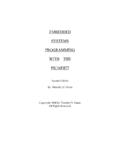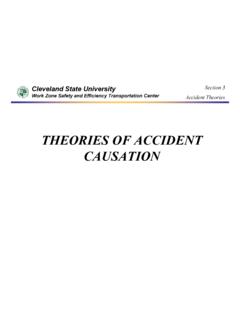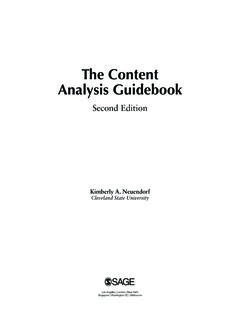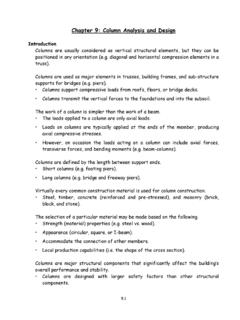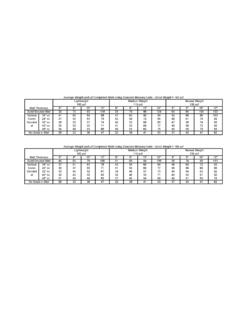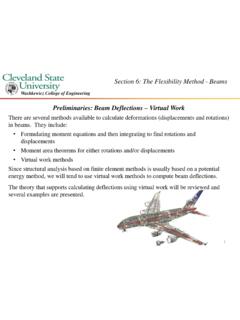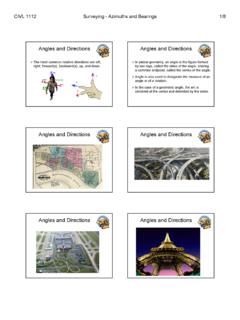Transcription of MEASURING DISTANCES USING STADIA METHODS
1 Fenn College of Engineering Cleveland State University Civil Engineering Department 216-687-2400 Cleveland, Ohio 44115 _____ Prof. Duffy PhD, PE, F. ASCE Revised: 10/29/2006 Page 1 216-687-3874 Stilwell Hall 114 CVE 212 - Surveying Lab #6 MEASURING DISTANCES USING STADIA METHODS EQUIPMENT Transit or theodolite with STADIA hairs and tripod Philadelphia leveling rod Field book No. 3 drafting pencil INTRODUCTION When DISTANCES between traverse stations are determined by the STADIA method, the resulting survey is called a STADIA traverse. The STADIA method, referred to as tacheometry in Europe, is a rapid and efficient way to measure DISTANCES in order to locate topographic details. The term STADIA comes from the Greek word for a unit of length originally applied in MEASURING DISTANCES for athletic contests.
2 This is also the origin of the word "stadiums." The distance signified 600 of the Greek equivalent of "feet." This converts to 606 feet 9 inches, which really has no significance in the surveying profession other than its relevance as an historical artifact. The term " STADIA " is now applied as an adjective describing the cross hairs or cross wires and the rod used in making measurements. In addition, the term is used to identify the STADIA method itself. The STADIA method is used in topographic and hydrographic surveys although, in general, its usefulness is declining because of advances in electronic distance MEASURING . The student is exposed to this method for research purposes. When gathering information in a property search DISTANCES may have been determined USING STADIA techniques in previous surveys.
3 This lab familiarizes the student with the STADIA method and the accuracy of measurements relative to taping a distance as well as determining a distance with an EDMI. Equipment for STADIA measurements includes a graduated level rod (for this lab the student will utilize a Philadelphia rod) and a transit/theodolite with a telescope that has two STADIA hairs, , a top STADIA hair and a bottom STADIA . The STADIA constant (see the theoretical development below) is imprinted by the instrument manufacturer on a plate attached the transit/theodolite. Level rods are made from wood, metal or fiber glass and are graduated in feet or meters. Unlike a surveyor s tape a level rod is marked continuously along its full length. On the Philadelphia rods used in this lab large red numerals designate whole feet, while small black numerals designate tenths of feet.
4 Tenth-of-a-foot points and odd five-hundredth-of-a-foot points are indicated by projecting angled cuts on somewhat longer black bars. The exact tenth-of-a-foot point is designated by a projection on top of the adjacent black bar while the exact five-hundredth-of-a-foot point is designated by a projection on the bottom of the corresponding adjacent black bar. Other exact Fenn College of Engineering Cleveland State University Civil Engineering Department 216-687-2400 Cleveland, Ohio 44115 _____ Prof. Duffy PhD, PE, F. ASCE Revised: 10/29/2006 Page 2 216-687-3874 Stilwell Hall 114 hundredth-of-a-foot marks are designated by either the top or bottom edge of shorter squared-off black bars. At first the gradation on a Philadelphia rod can seem complex to the student.
5 However, the reading method is quickly learned with practice. For short sight DISTANCES , , less than 500 ft., the ordinary leveling rod may be used. Beyond this distance the markings of a Philadelphia level rod become indistinct, and a rod with a pattern consisting of larger divisions should be utilized. However, for long sight DISTANCES the surveyor is better off determining line lengths USING an EDMI. The STADIA method of measurement is rapid and the results are sufficiently accurate for certain types of surveys. Under favorable conditions, the error associated with STADIA surveys will not exceed 1/500. In combination with the measurement of vertical angles, height differences can be calculated. The geometry utilized in the theoretical development of STADIA measurements for a horizontal sight with an external focusing telescope is depicted in the following figure.
6 The distance between the top and bottom STADIA hair is identified as i ( STADIA hair spacing). The distance between the top and bottom reading on the rod is identified as I ( STADIA intercept). The distance from the instrument operator s eye to the STADIA reticle (eyepiece) is identified as f (focal length). The distance from the instrument operator s eye to the level rod is identified as D, which is the quantity being determined in a STADIA survey. From similar triangles DIfi= which leads to Fenn College of Engineering Cleveland State University Civil Engineering Department 216-687-2400 Cleveland, Ohio 44115 _____ Prof. Duffy PhD, PE, F. ASCE Revised: 10/29/2006 Page 3 216-687-3874 Stilwell Hall 114 DfiI= The ratio of focal length to STADIA hair spacing is a constant for an instrument and is identified as K, the STADIA interval factor, , Kfi= Thus the distance from the instrument operator s eye to the rod is DKI= Thus the student records the top and bottom readings on the rod and calculates the distance USING the STADIA interval factor for the instrument in use.
7 The preceding discussion was based on the fact that the telescope of the instrument is level, , horizontal sights were taken. The surveyor may encounter situations where sighting on the level rod with the telescope level leads to an impractical number of instrument setups. This is a function of the terrain. Here the surveyor can conveniently rotate the telescope up or down to take readings on the rod. However, in doing so the instrument operator must record an additional piece of information in order to determine not only the horizontal distance between the instrument and the level rod, but also the vertical distance between the survey point the level rod is resting on and the HI of the instrument. This additional piece of information is the vertical angle . Utilizing the following figure Fenn College of Engineering Cleveland State University Civil Engineering Department 216-687-2400 Cleveland, Ohio 44115 _____ Prof.
8 Duffy PhD, PE, F. ASCE Revised: 10/29/2006 Page 4 216-687-3874 Stilwell Hall 114 the horizontal distance is given by the expression ()HKI=cos2 The vertical distance is given by the expression ()VKI=sin 22 PROCEDURE A transit/theodolite should be removed from its storage container by lifting the instrument from its base. Do not remove the instrument by grasping the telescope. The instrument base must be screwed snugly on the tripod. If the head is too loose, the instrument is unstable; if too tight, it may freeze on the tripod. The legs of the tripod must be tightened correctly. The tripod legs are tightened to a degree that if the instrument operator lifts a tripod leg up, the tripod leg will lower itself back to the ground under the force of its own weight.
9 Clamping them too tightly strains the plate and screws. If the legs are loose, the instrument wobbles. For this particular lab it will be necessary to set the level up over a specific point. Since the objective of the lab is to measure DISTANCES along the traverse previously measured with the surveyor s tape, the instrument must be positioned over each bench mark in the traverse. The student surveyor is reminded that the most convenient height for the telescope is one which enables the instrument operator to sight through the telescope without stooping or stretching. Typical instruments have bases with four adjusting screws, or three adjusting screws. For an instrument with four adjusting screws the telescope is rotated until the line of sight along the telescope intersects two opposing adjusting screws (see the figure below).
10 The bubble is approximately centered by USING the thumb and first finger of each hand to adjust the opposing screws. The procedure is repeated with the telescope over the remaining two opposing leveling screws. Time can wasted by centering the bubble exactly on the first position since this effort in leveling the instrument will be thrown off during the cross leveling of the telescope in the second position. Continue to adjust the instrument over each pair of adjusting screws until the level bubble remains centered no matter what direction the telescope is pointed. This usually requires about three pairs of adjustments. Fenn College of Engineering Cleveland State University Civil Engineering Department 216-687-2400 Cleveland, Ohio 44115 _____ Prof.
